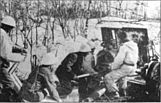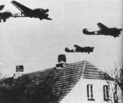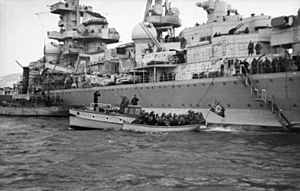Operation Weserübung facts for kids
Quick facts for kids Operation Weserübung |
|||||||||
|---|---|---|---|---|---|---|---|---|---|
| Part of European theatre of World War II | |||||||||
|
|||||||||
|
|||||||||
| Belligerents | |||||||||
|
|||||||||
| Commanders and leaders | |||||||||
|
|
||||||||
| Strength | |||||||||
|
|
||||||||
| Casualties and losses | |||||||||
|
|
||||||||
Operation Weserübung was the code name for Germany's surprise attack on Denmark and Norway during World War II. It happened from April 9 to June 10, 1940. This operation marked the start of the Norwegian Campaign.
On April 9, 1940, Germany invaded both Denmark and Norway. They claimed it was to protect these countries from a planned British and French attack. However, this plan by Britain and France was actually a response to possible German actions against Norway. The invasion involved very different military actions in Denmark and Norway because of their different landscapes and locations.
Contents
Importance of Iron Ore
In 1939, Britain saw Scandinavia as a possible battleground. The British government wanted to avoid another big land war like World War I. So, they thought about using a blockade to weaken Germany.
Germany needed a lot of iron ore for its industries. Much of this ore came from northern Sweden. It was often shipped through the Norwegian port of Narvik during winter. Controlling the Norwegian coast would help Britain stop these shipments to Germany.
In October 1939, the head of the German navy, Grand Admiral Erich Raeder, talked to Adolf Hitler. He warned about the danger of Britain setting up naval bases in Norway. He suggested Germany should take these bases first.
The navy believed that controlling Norway would help them control the nearby seas. It would also be a good place to launch submarine attacks against the United Kingdom. However, other parts of the German military were not interested at first. Hitler decided to focus on a land attack through the Low Countries.
British Mining Plans
In November 1939, Winston Churchill, a new member of the British War Cabinet, suggested mining Norwegian waters. This plan was called Operation Wilfred. The idea was to force German ore ships into the open North Sea, where the British navy could easily stop them.
Churchill thought this would make Germany react in Norway. Then, the Allies could use Plan R 4 to occupy Norway. This plan was put into action later, but at first, it was rejected. British leaders worried about upsetting neutral countries like the United States.
The start of the Winter War between the Soviet Union and Finland in November 1939 changed things. Churchill again proposed his mining plan, but it was denied once more.
Allied Plans for Finland
In December 1939, Britain and France started planning to send help to Finland. Their plan was to land troops in Narvik, Norway. Narvik was the main port for Swedish iron ore. From there, they would take control of the railway line to Luleå in Sweden. This would also let them occupy the Swedish iron ore mining area.
This plan was supported by British leaders. They hoped Norway would cooperate, which would solve some legal issues. But Germany warned Norway and Sweden, leading to strong negative reactions from both countries. Planning continued, but the reason for the expedition ended when Finland and the Soviet Union signed a peace treaty in March 1940.
Planning the Invasion
After meeting with Vidkun Quisling from Norway in December 1939, Hitler became very interested in Scandinavia. He was convinced that the Allies posed a threat to Germany's iron ore supply. So, Hitler ordered the German military command (OKW) to start planning an invasion of Norway. This first plan was called Studie Nord and involved only one army division.
Expanding the Plan
Between January 14 and 19, the German navy developed a bigger plan. They decided that surprise was key to reduce Norwegian resistance and British involvement. They also decided to use fast German warships to transport troops instead of slow merchant ships. This would allow all targets to be attacked at the same time.
The new plan called for a full army corps. This included a mountain division, an airborne division, a motorized rifle brigade, and two infantry divisions. The main targets were the Norwegian capital, Oslo, and other important cities like Bergen, Narvik, Tromsø, Trondheim, Kristiansand, and Stavanger. The plan also aimed to quickly capture the Kings of Denmark and Norway to force a fast surrender.
On February 21, 1940, General Nikolaus von Falkenhorst was put in charge of the operation's ground forces. He knew about Arctic warfare from fighting in Finland during World War I.
Finalizing Operation Weserübung
The final plan was named "Operation Weserübung" on January 27, 1940. The ground forces would be the XXI Army Corps, with the 3rd Mountain Division and five infantry divisions. None of these divisions had fought in battle before. The first attack would use three divisions, with the rest following later. Three companies of paratroopers would capture airfields. The 2nd Mountain Division was added later.
Almost all German U-boat operations in the Atlantic were stopped to help with this operation. All available submarines, even training boats, were used to support Operation Weserübung.
Initially, the plan was to invade Norway and gain control of Danish airfields through talks. But on March 1, Hitler ordered the invasion of both Norway and Denmark. This was because the German air force (Luftwaffe) wanted to capture fighter bases and air warning stations. The XXXI Corps, formed for the invasion of Denmark, had two infantry divisions and an armored brigade. The entire operation would be supported by the X Air Corps, with about 1,000 aircraft.
Before the Invasion
In February, a British navy ship, HMS Cossack, stopped the German transport ship Altmark in Norwegian waters. This was a violation of Norway's neutrality. The Altmark was carrying British prisoners-of-war. Hitler saw this as a sign that the Allies were also willing to ignore Norway's neutrality. This made him even more determined to invade.
On March 12, Britain decided to send troops to Norway as the Winter War was ending. The troops started boarding ships on March 13. But the operation was canceled because the Winter War ended. Instead, the British Cabinet decided to go ahead with mining Norwegian waters and then landing troops.
The first German ships for the invasion sailed on April 3. Two days later, the British Operation Wilfred began. British navy ships, led by HMS Renown, left to mine Norwegian waters. The mines were laid on the morning of April 8. Later that day, a British destroyer, HMS Glowworm, was sunk by the German heavy cruiser Admiral Hipper and two destroyers. These German ships were part of the invasion fleet.
On April 9, the German invasion began, and the British Plan R 4 was quickly put into action.
Invasion of Denmark

Denmark was important to Germany because it was a good place to start operations in Norway. Also, because it bordered Germany and was on the Baltic Sea, it was key for controlling naval access to German and Soviet ports.
At 4:00 AM on April 9, 1940, the German ambassador to Denmark, Cecil von Renthe-Fink, met with Danish Foreign Minister Peter Munch. Renthe-Fink announced that German troops were entering Denmark to protect it from British and French attacks. He demanded that Denmark stop resisting immediately. If they didn't, the German air force (Luftwaffe) would bomb Copenhagen, the capital.
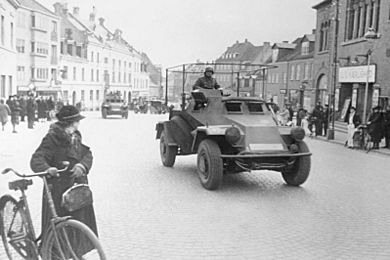
Even as these demands were being made, German forces had already started their invasion. Troops landed by ferry in Gedser and moved north. German paratroopers landed without resistance and took two airfields at Aalborg, the Storstrøm Bridge, and the fortress of Masnedø. The attack on Masnedø was the first time paratroopers were used in a battle.
At 4:20 AM, German infantry landed in Copenhagen harbor from the minelayer Hansestadt Danzig. They quickly captured the Danish garrison at the Citadel without a fight. From the harbor, the Germans moved towards Amalienborg Palace to capture the Danish royal family.
By the time the Germans reached the palace, the King's Royal Guard was ready. The first German attack on Amalienborg was pushed back. This gave King Christian X and his ministers time to talk with the Danish Army chief, General Prior. While they talked, German bombers flew over the city, dropping leaflets that said "OPROP!" (proclamation) in Danish.
At 5:25 AM, German fighter planes attacked Værløse airfield on Zealand. They destroyed ten Danish aircraft and damaged fourteen others, wiping out half of the Danish Army Air Service.
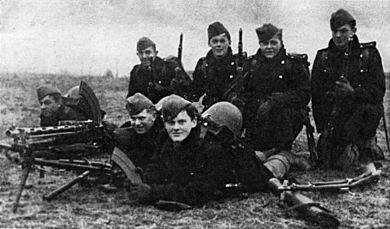
Faced with the threat of Copenhagen being bombed and with only General Prior wanting to fight on, King Christian and the Danish government surrendered around 6:00 AM. In return, Denmark was allowed to keep some control over its own affairs.
The invasion of Denmark lasted less than six hours. It was the shortest military campaign by the Germans in the war. Because Denmark surrendered so quickly, the German occupation was less harsh, especially until 1943. This also delayed the arrest of Danish Jews, giving most of them time to escape to neutral Sweden.
Invasion of Norway
Why Norway Was Important
Norway was important to Germany for two main reasons. First, it offered excellent bases for naval ships, including U-boats. These could be used to attack Allied shipping in the North Atlantic. Second, it secured the shipments of iron ore from Sweden through the port of Narvik. Germany relied on this iron ore. They worried that the Allies would try to stop these shipments, 90% of which came from Narvik.
German Forces for Norway
The invasion of Norway was led by the XXI Army Corps under General Nikolaus von Falkenhorst. It included several infantry and mountain divisions.
The first invasion force was carried by German navy ships:
- Battleships Scharnhorst and Gneisenau provided cover. Ten destroyers carried 2,000 mountain infantry to Narvik.
- Heavy cruiser Admiral Hipper and four destroyers carried 1,700 troops to Trondheim.
- Light cruisers Köln and Königsberg and other ships carried 1,900 troops to Bergen.
- Light cruiser Karlsruhe and other ships carried 1,100 troops to Kristiansand and Arendal.
- Heavy cruiser Blücher, heavy cruiser Lützow, light cruiser Emden, and other ships carried 2,000 troops to Oslo.
- Four minesweepers carried 150 troops to Egersund.
The Invasion Begins
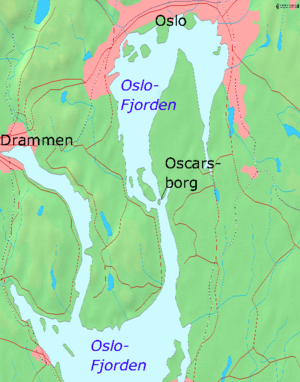
On April 8, a German troopship, SS Rio de Janeiro, was sunk by a Polish submarine off Lillesand. News of this sinking reached Norwegian officials too late to make a big difference. Later that evening, German ships were spotted by a Norwegian guard vessel. The Norwegian captain was the first Norwegian killed in the invasion.
German ships then sailed up the Oslofjord towards the capital. In the early morning of April 9, gunners at Oscarsborg Fortress fired on the leading ship, the Blücher. The fortress used old German-made guns. Within two hours, the badly damaged Blücher sank with a huge loss of life (600–1,000 men).
The sinking of the Blücher delayed the German naval invasion group. This gave the Royal Family, the government, and members of Parliament time to escape. They also took the national treasury with them. Because the Norwegian king and his government were not captured, Norway never officially surrendered to the Germans. The Norwegian government continued to fight from London.
Battles Across Norway
On April 9, German airborne troops landed at airports in Oslo, Kristiansand, and Sola. The attack on Sola Air Station was the first time paratroopers attacked an enemy position in history.
Later that day, the Norwegian destroyer Æger was sunk near Stavanger by German bombers. It had just sunk a German cargo ship carrying weapons for the invasion. Cities like Bergen, Stavanger, Kristiansand, Trondheim, and Narvik were attacked and occupied within 24 hours.
At Narvik, Norwegian coastal defense ships tried to resist but were sunk with many lives lost. On April 10, the First Battle of Narvik took place between British and German destroyers. Both sides lost ships. On April 13, a British attack by the battleship HMS Warspite sank the remaining German destroyers, which were trapped in Narvik.
Many Norwegian towns, including Nybergsund, Elverum, and Narvik, were heavily bombed by the Germans. The main German land campaign moved north from Oslo. Norwegian soldiers, along with some British and French troops, fought hard but were eventually forced to give up. This was the first time the British Army fought the German Wehrmacht in World War II.
In land battles at Narvik, Norwegian and Allied forces achieved the first major tactical victory against the Germans in WWII. The King and his government moved from Molde to Tromsø on April 29. Allied troops left Åndalsnes on May 1. Resistance in Southern Norway then ended.
Hegra Fortress continued to resist German attacks until May 5. King Haakon, Crown Prince Olav, and the Cabinet left from Tromsø on June 7 aboard a British cruiser to represent Norway in exile. The Norwegian Army in mainland Norway surrendered on June 10, 1940. This made Norway the occupied country that resisted a German invasion for the longest time. Even after the main forces surrendered, the Royal Norwegian Navy and other armed forces continued fighting abroad and in the resistance until Germany surrendered in 1945.
In the far north, Norwegian, French, and Polish troops, supported by the British navy and air force, fought for control of Narvik. The Germans were driven out of Narvik on May 28. However, because the war situation in Europe was getting worse, the Allied troops had to leave. On June 9, the Germans recaptured Narvik.
Sweden and Finland Surrounded
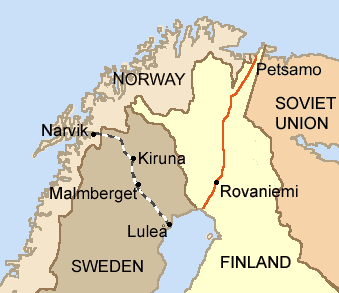
Operation Weserübung did not include an attack on neutral Sweden. By controlling Norway, the Danish straits, and most of the Baltic Sea coast, Germany surrounded Sweden from the north, west, and south. To the east was the Soviet Union, which was friendly with Hitler at the time.
Swedish and Finnish trade depended on the German navy. Germany pressured neutral Sweden to allow German military goods and soldiers to pass through. An agreement was reached on June 18, 1940. Soldiers had to travel unarmed and not as part of military units. Over 2 million German soldiers and more than 100,000 German military railway cars crossed Sweden until this traffic stopped in August 1943.
On August 19, 1940, Finland also agreed to let the German military use its territory. This was initially for moving troops and equipment to and from northern Norway. But soon, it included small bases along the transit route, which grew as Germany prepared for Operation Barbarossa.
The Nuremberg Trials and Preemptive War
After the war, during the Nuremberg trials in 1946, Germany argued that its invasion of Norway was a "preemptive" attack. They claimed they had to attack Norway to stop an Allied invasion. The German defense tried to use the Allied Plan R 4 as proof.
However, it was found that Germany had discussed invading Norway as early as October 1939. A memo from Admiral Raeder to Alfred Rosenberg asked if bases could be taken by force against Norway's will. Norway was very important to Germany for transporting iron ore from Sweden, which Britain wanted to stop.
Allied invasion plans were ordered on March 12, and the Germans intercepted radio traffic about preparations. But peace in Finland interrupted these Allied plans.
Diary entries from a German general, Alfred Jodl, on March 13 and 14, showed that Hitler was actively thinking about starting "Weser Exercise." One entry said, "Führer does not give order yet for 'Weser Exercise.' He is still looking for an excuse." Another said, "Führer has not yet decided what reason to give for Weser Exercise." German preparations were not finished until April 2, 1940. The order for Weserübung was issued on April 4.
The new Allied plans were Wilfred and Plan R 4. The idea was to provoke Germany by laying mines in Norwegian waters. Once Germany reacted, British troops would occupy Narvik, Trondheim, and Bergen. They would also raid Stavanger to destroy its airfield. However, "the mines were not laid until the morning of 8 April, by which time the German ships were advancing up the Norwegian coast."
The International Military Tribunal at Nuremberg decided that no Allied invasion was about to happen. So, they rejected Germany's argument that it had the right to attack Norway.
See also
- List of Danish military equipment of World War II
- Battle of Kristiansand
- List of Norwegian military equipment of World War II
- British occupation of the Faroe Islands in World War II
- List of British military equipment of World War II
- List of French World War II military equipment
- Kampf um Norwegen – Feldzug 1940 (1940 documentary film)
- List of German military equipment of World War II
- Luftwaffe Order of Battle April 1940
- Occupation of Norway by Nazi Germany
- Operation Juno
- Operation Weserübung's effects on Sweden
- Timeline of the Norwegian Campaign




